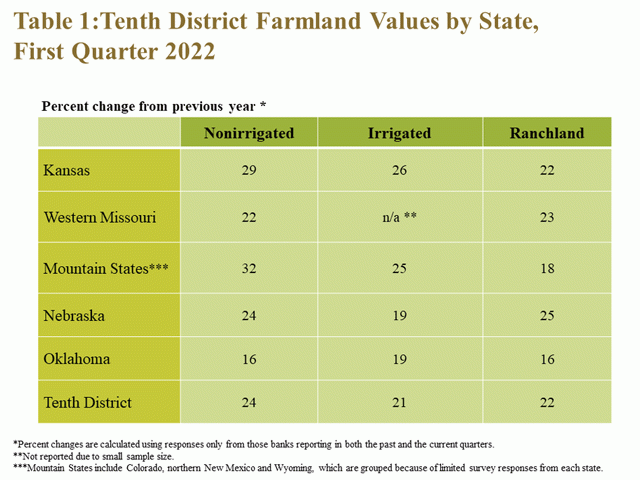Surveys Show Pasture Values on the Rise
Pastureland Values Keep Pace with Rising Cropland Values
MT. JULIET, Tenn. (DTN) -- The value of ranch and pastureland kept pace with cropland in 2021 and early 2022, although regional variations were evident, according to economists at the Federal Reserve Bank of Kansas City.
The value of ranchland in Nebraska was 25% higher in the first quarter of 2022 compared to the year before, while bankers estimated non-irrigated cropland values gained 24%.
In the mountain states covered by the Kansas City Federal Reserve district -- which includes Colorado, northern New Mexico and Wyoming -- the value of pastureland gained just 18% compared to cropland's 32% jump. The KC Fed consolidates responses from those states because of the limited amount of survey data from that region.
Nathan Kauffman, Kansas City Fed vice president and agriculture economist, told DTN in an interview that farmland values tend to reflect the financial conditions of agriculture, and local conditions do make a difference.
P[L1] D[0x0] M[300x250] OOP[F] ADUNIT[] T[]
"When there's a severe drought in a particular area for a long period of time, we can see that play out in values," he said. "So, parts of the region we cover in the far south or the west that have been in more persistent drought, we maybe see a little bit more weakness in some of those areas."
All of Colorado, Wyoming and New Mexico are in some stage of drought, with more than 90% of New Mexico falling in the extreme to exceptional category. (For more on New Mexico's drought, please read "Farming Famous Hatch Chiles Along the Rio Grande River, Where Water Quickly Runs Dry" here: https://www.dtnpf.com/….)
Kauffman said the rapid jump in commodity prices during the past year or so poured fuel on the farmland market, but now concerns about rising input costs are raising questions about future farm profitability.
"We tend to see quicker increases in land prices, and cash rents are slower to follow, but we've started to see more pressure now on cash rents," Kauffman said.
In North Dakota, pastureland values jumped 11.5% in 2021, to a statewide average of $1,080 per acre, according to data from the North Dakota Department of Trust Lands annual survey. However, the average cash rent for pasture was unchanged at $21 per acre. Byron Parman, an agricultural finance specialist at North Dakota State University, said that some areas saw higher rents, while others were lower.
"While it is common for rental rates and pastureland values to move by different amounts within the data, such that values may increase by double digits while rental rate increases are in the lower single digits, it is less common for values to increase so remarkably while rents remain unchanged (or possibly decline)," he said in a press release.
He said the difference likely reflects the drought that North Dakota experienced in 2021.
"Land purchases are a longer-term investment and recent precipitation amounts have less of an impact in the short run, while rental rates may indeed be impacted by available standing or predicted forage amounts," Parman said. You can find more on North Dakota Land Values here: https://www.land.nd.gov/….
Katie Dehlinger can be reached at katie.dehlinger@dtn.com
Follow her on Twitter @KatieD_DTN
(c) Copyright 2022 DTN, LLC. All rights reserved.






